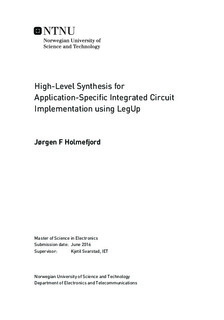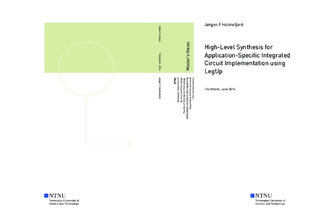| dc.description.abstract | Low power and small area are becoming increasingly important and highly demanded in large System-on-Chip (SoC) designs, incorporating billions of transistors. This entails that the typical design methodology is no longer sufficient, if hardware manufacturers want to supply the best product on the market. Architectural exploration is an important part of the design process, where multiple designs are built and evaluated in terms of area, performance, and power consumption. High-level synthesis (HLS) is a compelling alternative to reduce the effort put into architectural exploration. By using HLS in a framework for architectural exploration of digital hardware, the number and diversity of architectural variations that can be generated and evaluated is far greater than what could have been done manually.
During a previous project, the HLS-tool LegUp was explored. The goal was to see if the tool could be used the described framework. The conclusions from the project was that LegUp had some issues, limiting its ability to generate Register-Transfer Level (RTL)-code suitable for Application-Specific Integrated Circuit (ASIC) implementation.
This thesis presents a solution for an architectural exploration framework built on an adapted version of LegUp. The framework can generate a large amount of architectural variations of a design written in C, and run simulation, synthesis, layout and power analysis on each design. Randomized constraints are used in the framework to vary the output from the HLS-tool. The framework generate reports of area usage, maximum performance, and estimated power consumption for each of the generated designs, for the designer to be able to choose the best design based on trade-offs from the design specifications.
A proof of concept was conducted, running a FIR-filter design through the created framework. The result showed that a decrease in area of 13.28% and a decrease in power consumption of 9.52% could be achieved by selecting the best-case design over the worst-case design. These results indicate that the concept works. The overhead of the generated designs vary between 30-200%, making it impractical for hardware design. However, it looks like the fidelity of the results are high, making it possible to use the framework-results for selecting the best architecture. During the process of adapting LegUp to work with a tool-flow for ASIC implementations, some of the functionality of the tool have been lost. Some bugs has also been introduced and discovered. Before using the created framework for any commercial purpose, these problems must be eliminated. | |

